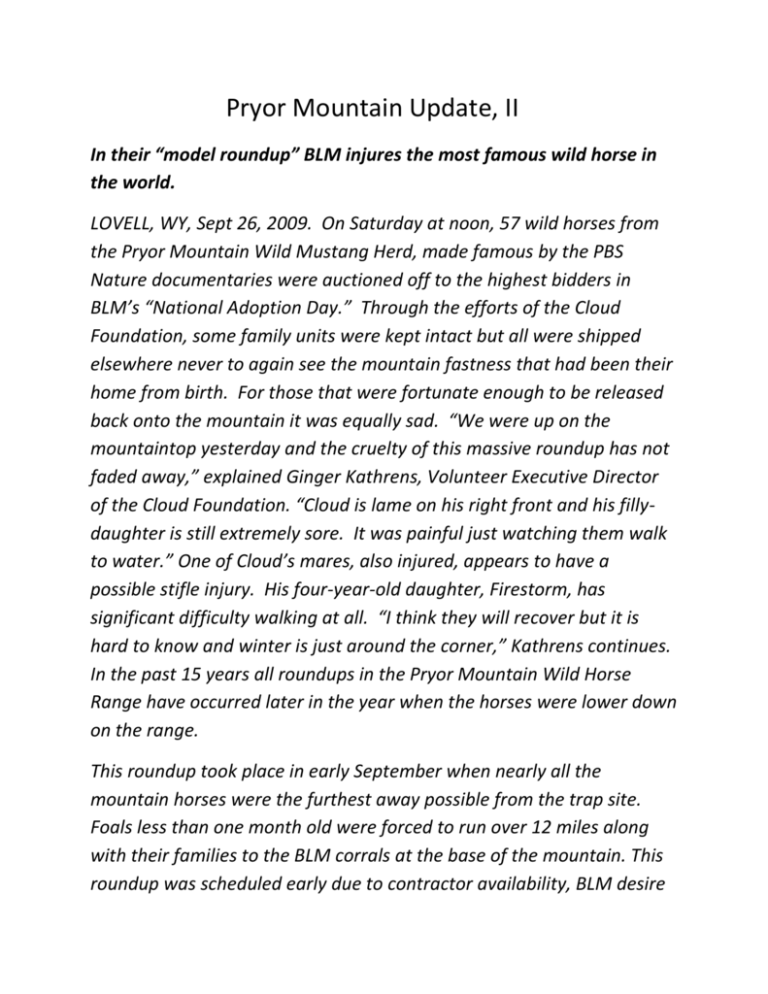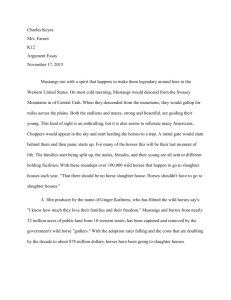
Pryor Mountain Update, II
In their “model roundup” BLM injures the most famous wild horse in
the world.
LOVELL, WY, Sept 26, 2009. On Saturday at noon, 57 wild horses from
the Pryor Mountain Wild Mustang Herd, made famous by the PBS
Nature documentaries were auctioned off to the highest bidders in
BLM’s “National Adoption Day.” Through the efforts of the Cloud
Foundation, some family units were kept intact but all were shipped
elsewhere never to again see the mountain fastness that had been their
home from birth. For those that were fortunate enough to be released
back onto the mountain it was equally sad. “We were up on the
mountaintop yesterday and the cruelty of this massive roundup has not
faded away,” explained Ginger Kathrens, Volunteer Executive Director
of the Cloud Foundation. “Cloud is lame on his right front and his fillydaughter is still extremely sore. It was painful just watching them walk
to water.” One of Cloud’s mares, also injured, appears to have a
possible stifle injury. His four-year-old daughter, Firestorm, has
significant difficulty walking at all. “I think they will recover but it is
hard to know and winter is just around the corner,” Kathrens continues.
In the past 15 years all roundups in the Pryor Mountain Wild Horse
Range have occurred later in the year when the horses were lower down
on the range.
This roundup took place in early September when nearly all the
mountain horses were the furthest away possible from the trap site.
Foals less than one month old were forced to run over 12 miles along
with their families to the BLM corrals at the base of the mountain. This
roundup was scheduled early due to contractor availability, BLM desire
to remove all horses from Commissary Ridge outside the designated
range (a plan not revealed to the public until day one of the roundup)
and National Adoption Day. The BLM held adoption events across the
country: “This is a significant event and will raise awareness for
mustangs” said the BLM. So “why did they have to pillage this little
herd for 57 more horses to adopt out when there are 31,750 wild horses
in holding already is beyond me,” said Kathrens.
Legislation directing the BLM “to develop a new comprehensive longterm plan for wild horse populations by September 30, 2010” passed
the Senate on Sept. 24, 2009,according to a press release from the
legislation’s sponsor, Senator Mary Landrieu (D-LA).
The Secretary of the Interior, Mr. Salazar, unveiled his new plan as a
“national solution to restore the health of America’s wild horse herds
and the rangelands that support them by creating a cost-efficient,
sustainable management program that includes the possible creation of
wild horse preserves on the productive grasslands of the Midwest and
East.”
That sounds good on the surface but when you examine it carefully it
has the potential to empower the BLM to manage the horses to
extinction. The BLM’s plan includes blocking reproduction, creating
“gelding herds”, removing wild horses from their historic ranges, and
creating manned, staffed preserves where they can be “show cased” to
the public.
As Ginger Kathrens succinctly phrased it: “ it takes the wild out of wildhorse herds. They’re families in sophisticated societies. Creating
gelding herds and preventing them from reproducing is managing them
toward extinction.”
At the turn of the century, there were approximately 2 million wild
horses in America, there are only 33,100 mustangs left now on the
western ranges according to the BLM. Today, there are 180 existing,
unmanned federal Herd Management Areas (HMAs) (in English “wildhorse areas”) in the West. That is a loss of 15% over the last 15 years.
Despite the 1971 law, demand by ranchers, energy companies, and
homeowners means wild horses run in ever tighter circles.
The 1971 Wild Horse Act, was aimed at preserving the horses where
presently found. This was reaffirmed last August by the US District
Court for the District of Columbia in its decision to prevent the capture
of Colorado 's West Douglas herd. The Court stated in part:Congress did
not authorize BLM to manage the wild horses by corralling them for
private maintenance or long-term care as non-wild free-roaming
animals off the public lands.? The Court deemed removal for long-term
care to be contrary to Congress intent to protect the horses from
capture as components of the public lands.
Ms. Kathrens, the wild-horse advocate, said that instead of taking the
horses off the wild land, the government should put a priority on
reducing the millions of head of cattle that graze on public lands, so
that horses would have more room. " In 2006, cattle and sheep
consumed twenty times as much forage on BLM land as wild horses and
burros. How can a species that constitutes only half a percent of large
grazing animals on public lands be a scapegoat time and time again for
range degradation? As a rancher himself, surely Mr. Salazar is aware of
the millions of head of private cattle that graze the same public range
as America 's few thousand wild horses. Yet, Mr. Salazar wants to
continue removing wild horses from their rightful Western range. Over
30 million dollars will be spent in fiscal year 2010 to capture over
12,000 wild horses and burros!
I have to say that I would rather eat feedlot raised beef than I would to
see the horses in the damn feedlot and the cattle on the wild lands.
Be sure to watch Ginger’s documentary on October 25th to see the
horses at peace before the BLM’s removal this past month.
As the American Wild Horse Preservation Campaign Team wrote:
“While we applaud the government’s efforts toward a more humane
approach, Secretary Salazar's new initiative is another step toward the
privatization of America 's iconic wild herds and away from the survival
of the American wild horse in its natural state as an integral part of the
Western landscape. More than ever, a moratorium on roundups is in
order until actual numbers of wild horses and burros on public lands
have been independently assessed, and legally-mandated range studies
have been conducted.”
Questions Congress should be asking include:
Will the new BLM preserves be established for the benefit of the 32,000
horses currently held by BLM, or will they constitute an outlet for
further roundups? Will the remaining Western herds be managed in the
wild at genetically viable levels?
Mr. Salazar is not on the moral high ground and we are right back
where we were when I told you that the only place you would be able
to see a wild horse is either in the BLM's pens or on film because they
are going to be like the reservation Indians, simply gone because man
wanted money.
Bottom line is that the ROAM Act needs to be passed so that the horses
can reclaim the more than 19 million acres they have lost since being
granted federal protection. And we need to be real careful about the
wording as the BLM may have some different interpretations than we
do of what a “healthy” horse is. We let the fox in the hen house in
1971 by tasking the BLM to “manage” the wild horse herd.
Maybe it is just this old cowboy, but I believe wild horses should be
viewed in the wild behaving as wild horses do in functioning bands.
Captive, gelded, non-reproducing herds don’t begin to convey the
majesty of these icons of the West. It smacks of the buffalo in the pen
at the road side gas station….picnic supplies, curios.
John M. Hutcheson, Dahlonega, GA
Please write your congressman and tell him to push to get the ROAM
Act up for a vote.
Please paraphrase my article to construct your own letter. If you as a
horseman won’t write a letter or make a call, who will?
Thanks,
Hutch
Copyright John M. Hutcheson, 539 Gab Creek Farm Road, Dahlonega,
GA, 706-864-3690. ALL RIGHTS RESERVED.








